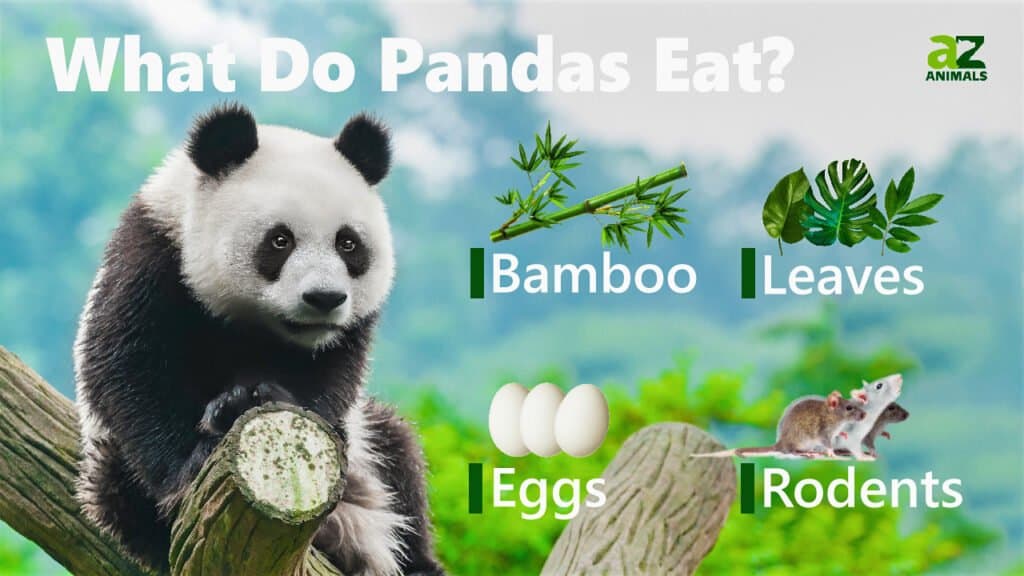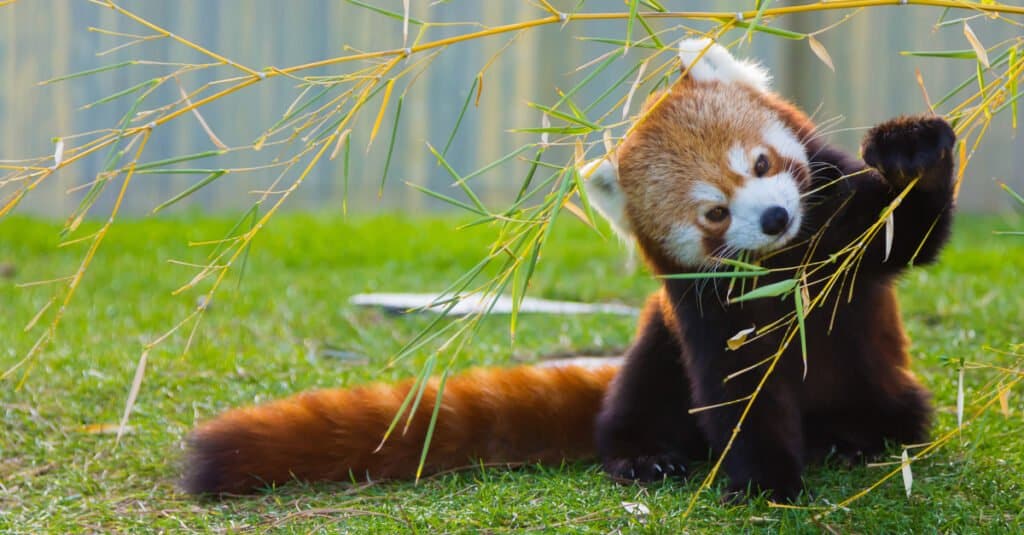There’s often public confusion around the relationship between the two identified species of pandas — but it only makes sense when you consider that these animals are only distantly related and demonstrate dramatic differences in everything from physiology to habitat to behaviors.
The name panda is derived from the Nepali word for “bamboo eater”, and the link between these animals breaks down almost entirely according to dietary and nutritional habits.
Despite being the less well-known of the two, the facts show red pandas earned the name ten years before the giant panda in 1825. It’s an example of how challenging it was to trace evolutionary family trees before the advent of DNA testing, but it’s also proof of how convergent evolution can cause distinct species to develop the same highly specialized — and highly unusual — behaviors in isolation from one another.
Here’s everything you could want to know about how giant pandas and red pandas eat.
What Do Pandas Eat?

One way to better understand how natural selection influences diets is to identify animals as generalists or specialists. Generalists can subsist on a variety of different food sources — and this behavior has allowed omnivorous coyotes to find suitable ecosystems stretching over most of the United States and herbivorous elephants to serve as African gardeners pruning vegetation along migration routes that can extend over 60 miles.
Specialists like flamingos and koalas — which feed primarily on shrimp and eucalyptus leaves respectively — often manage to flourish by finding a food source that’s readily available but has little competitive demand. But the practical facts behind specialization also make them particularly vulnerable to habitat destruction.
This is the case with red pandas and giant pandas, which have two of the most specialized and bizarre diets on the planet. The latter subsists of a diet that’s 99% bamboo species, while the former has a slightly more varied diet that’s between 85 and 95% bamboo. If that seems like a boring diet, there’s at least some solace in the fact that there’s a little variety sprinkled in there. Roughly 40 bamboo species can be found in the overlapping habitats of red and giant pandas.
Giant pandas are known to selectively feed on over 20 different varieties, while red pandas will usually feed on only one or two. Despite that, red pandas may exhibit a more varied diet overall since they feed on a wider range of foods outside of bamboo.
Giant pandas eat a diet that includes:
- Bamboo shoots, leaves, and culm (roughly 20 species, 99% of overall diet)
- Meat (pikas, rodents, insects)
- Carrion
- Crops (wheat, pumpkins, kidney beans, livestock feed)
Red pandas eat a diet that includes:
- Bamboo shoots and leaves (1-2 species, 85 – 95% of overall diet)
- Meat (insects, mice, rats, eggs, and small lizards or birds when pregnant)
- Plants (bark, lichen, roots, grass, flowers)
- Other vegetation (berries, fruits, mushrooms, acorns)
Additionally to bamboo and the occasional protein, pandas also love fruit! They especially love apples. Pandas have also been known to like something known as a “panda cake” which is basically just steamed corn bread. In the summer, pandas enjoy frozen ice with bits of apple inside them to cool them down. Furthermore, Pandas enjoy veggies like carrots, ginseng and even some funguses.
How Do Pandas Find Food?
Now you’ve discovered the answer to the question, “what do pandas eat?”, it’s time to look at just how they go about getting their food. Red and giant pandas have independently adapted to subsist mostly on bamboo, but they’ve also similarly developed “false thumbs” that allow them to grip and manipulate bamboo far more easily. But other physiological developments affect what parts of the bamboo plant each species eats.
The sharp and weasel-like teeth of the red panda are great for stripping bamboo shoots and leaf tips, but they leave the jointed stem known as the culm to giant pandas. This bear’s heavy, crushing teeth have been designed to effectively chew these stems.
Giant panda bears tend to selectively prioritize specific bamboo species and parts of the bamboo depending on the seasonal nutritional content. With fewer options to choose from, red pandas will usually supplement their diet with other food sources instead. Foraging is rarely an issue for either species of the panda, because bamboo tends to be available in abundance, and neither species has many natural predators.
How Can Pandas Live on a Diet of Mostly Bamboo?

©Jose Angel Astor Rocha/Shutterstock.com
Species largely manage to succeed by making the most efficient use of their energy, but pandas are an indication that low-efficiency diets can be sustainable when there’s both an abundance of the resource and minimal foraging or hunting needs. Giant pandas only digest 17% of the bamboo they eat, and they make up for that by consuming between 25 and 85 pounds of it a day. By contrast, red pandas can digest 24% of their bamboo diets and have to eat 20 to 30% of their body weight in a day to compensate. As a result, giant and red pandas need to spend 12 to 18 hours out of the day foraging and eating.
Did You Know Pandas Have the Digestive System of a Typical Carnivore?
Red and giant pandas may not be closely related, but their inefficiency at digesting bamboo is the result of the fact that they both have the digestive system of a carnivore. In contrast to the typical carnivore’s diet, bamboo is low in protein and fat and high in fiber. Both panda species have to be conscientious about energy consumption as a result. The facts of a 2010 genetic study indicate that both species developed their vegetarian diets after a mutation caused them to lose the ability to taste umami flavors, thus making meat an unappealing nutritional source.
What Animals Eat Pandas?
The lethargic and high-volume diets of pandas would be unsustainable if they faced serious predation. Red and giant pandas have overlapping habitats and naturally overlapping predators as well. Snow leopards are the primary threat, but jackals and martens have been known to prey on them as well.
In both cases, these animals will typically only prey on panda cubs. Red panda cubs are also threatened by some birds of prey. The biggest threat to pandas comes from human poaching and deforestation.
Next Up…
- Are Pandas Dangerous? – Pandas are known for being cute, docile, and almost lovable creatures. Are they dangerous to humans if threatened? Keep reading to find out!
- Red Panda vs Panda: 5 Key Differences – What are the key differences between a Red Panda and a Panda? Are they the same species? Learn now!
- How Many Pandas Are In The World? – Are Pandas going extinct? How many are left? Find out!
The photo featured at the top of this post is © Hung Chung Chih/Shutterstock.com
Thank you for reading! Have some feedback for us? Contact the AZ Animals editorial team.







